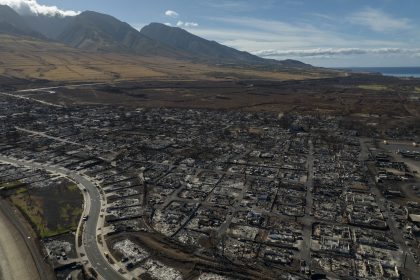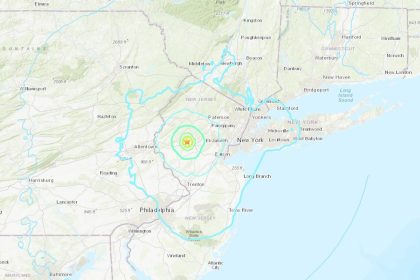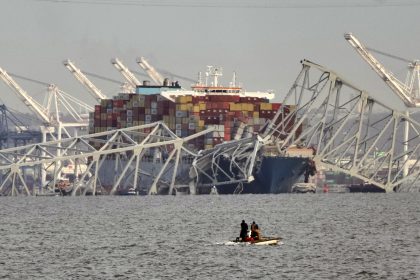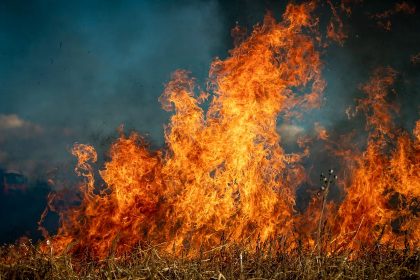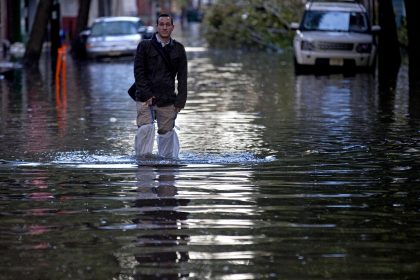Volcano Erupts in Pacific, West Coast Under Tsunami Advisory
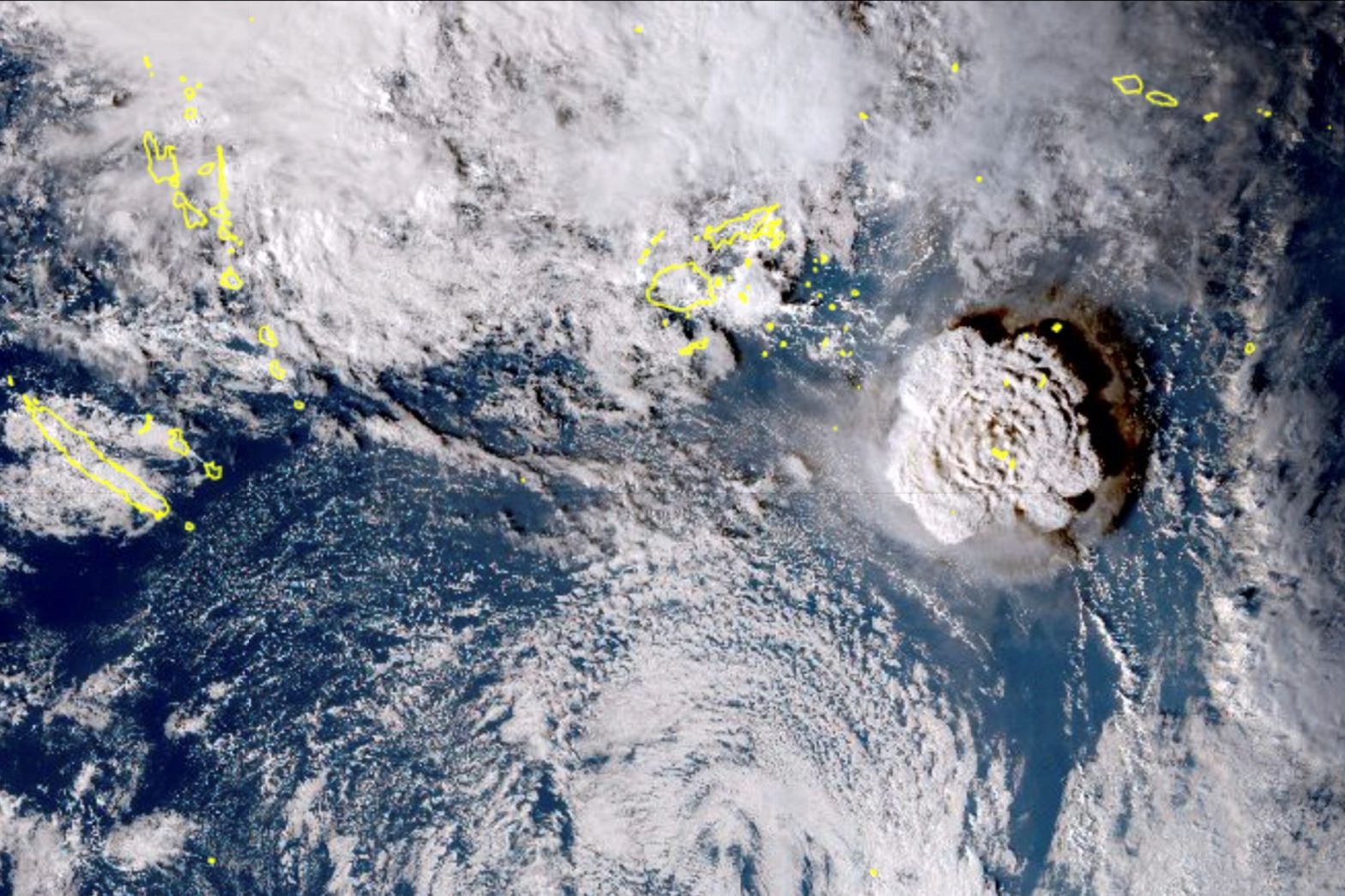
WELLINGTON, New Zealand (AP) — An undersea volcano erupted in spectacular fashion Saturday near the Pacific nation of Tonga, sending large tsunami waves crashing across the shore and people rushing to higher ground. A tsunami advisory was in effect for Hawaii, Alaska and the U.S. Pacific coast.
There were no immediate reports of injuries or on the extent of the damage because all internet connectivity with Tonga was lost at about 6:40 p.m. local time, said Doug Madory, director of internet analysis for the network intelligence firm Kentik.
Tonga gets its internet via an undersea cable from Suva, Fiji, which presumably was damaged. The company that manages that connection, Southern Cross Cable Network, could not immediately be reached for comment.
Tonga’s Islands Business news site reported that a convoy of police and military troops evacuated King Tupou VI from his palace near the shore. He was among the many residents who headed for higher ground.
In Hawaii, the Pacific Tsunami Warning Center reported waves that measured half a meter (1.6 feet) in Nawiliwili, Kauai and 80 centimeters (2.7 feet) in Hanalei. The National Weather Service said there were reports of boats getting pushed up in docks, but the hazard was diminishing.
“We are relieved that there is no reported damage and only minor flooding throughout the islands,” the tsunami center said, describing the situation in Hawaii.
On Tonga, home to about 105,000 people, video posted to social media showed large waves washing ashore in coastal areas, swirling around homes, a church and other buildings. Satellite images showed a huge eruption, with a plume of ash, steam and gas rising like a mushroom above the blue Pacific waters.
New Zealand’s military said it was monitoring the situation and remained on standby, ready to assist if asked.
The Tonga Meteorological Services said a tsunami warning was declared for all of the archipelago, and data from the Pacific tsunami center said waves of 80 centimeters (2.7 feet) were detected.
A Twitter user identified as Dr. Faka’iloatonga Taumoefolau posted video showing waves crashing ashore.
“Can literally hear the volcano eruption, sounds pretty violent,” he wrote, adding in a later post: “Raining ash and tiny pebbles, darkness blanketing the sky.”
The explosion of the Hunga Tonga Hunga Ha’apai volcano was the latest in a series of dramatic eruptions.
Earth imaging company Planet Labs PBC had been watching the island in recent days after a new volcanic vent there began erupting in late December.
Satellite images captured by Planet Labs show how drastically the volcano had shaped the area, creating a growing island off Tonga.
“The surface area of the island appears to have expanded by nearly 45% due to ashfall,” Planet said days before the latest activity.
Following Saturday’s eruption, residents in Hawaii, Alaska and along the U.S. Pacific coast were advised to move away from the coastline to higher ground and to pay attention to specific instructions from their local emergency management officials, said Dave Snider, tsunami warning coordinator for the National Tsunami Warning Center in Palmer, Alaska.
“We don’t issue an advisory for this length of coastline as we’ve done – I’m not sure when the last time was – but it really isn’t an everyday experience,” Snider said.
He said the waves slamming ashore in Hawaii were just under the criteria for a more serious tsunami warning.
“The important thing here is the first wave may not be the largest. We could see this play out for several hours,” he added. “It looks like everything will stay below the warning level, but it’s difficult to predict because this is a volcanic eruption, and we’re set up to measure earthquake or seismic-driven sea waves.”
The first waves to hit the continental United States measured about 30 centimeters (1 foot) in Nikolski and Adak, Alaska. A wave of about 20 centimeters (.7 feet) was observed in Monterey, California, the U.S. National Tsunami Warning Center said in a tweet.
Beaches and piers were closed across Southern California as a precaution. The National Weather Service tweeted there were “no significant concerns about inundation.” Strong rip currents were possible, however, and officials warned people to stay out of the water.
On California’s central coast, the National Weather Service reported tsunami waves up to 2.5 feet (.76 meters) and flooding in beach parking lots at Port San Luis. About 200 miles (320 km) down the coast, the waves were much smaller at Southern California’s Seal Beach, according to Michael Pless, the owner of M&M Surf School.
“The waves are looking pretty flat,” Pless said. “We’re hoping they reopen the beach in a couple hours.”
Crowds gathered at the Santa Cruz harbor in California early Saturday to watch water slowly rise and fall, straining boat ties on docks. In 2011, after the Japanese earthquake and tsunami, a series of surges cost $20 million of damage in the harbor.
Residents of American Samoa were alerted of the tsunami warning by local broadcasters as well as church bells that rang territory-wide. An outdoor siren warning system was out of service. Those living along the shoreline quickly moved to higher ground.
As night fell, there were no reports of any damage and the Hawaii-based tsunami center canceled the alert.
Authorities in the nearby island nations of Fiji and Samoa also issued warnings, telling people to avoid the shoreline due to strong currents and dangerous waves. The Japan Meteorological Agency said there may be a slight swelling of the water along the coast, but it was not expected to cause any damage.
More than 2,300 kilometers (1,400 miles) away from Tonga in New Zealand, officials warned of possible storm surges from the eruption.
New Zealand’s private forecaster, Weather, Watch tweeted that people as far away as Southland, the country’s southernmost region, reported hearing sonic booms from the eruption. Others reported that many boats were damaged by a tsunami that hit a marina in Whangarei, in the Northland region.
Earlier, the Matangi Tonga news site reported that scientists observed massive explosions, thunder and lightning near the volcano after it started erupting early Friday. Satellite images showed a 5-kilometer (3- mile) -wide plume rising into the air to about 20 kilometers (12 miles).
The Hunga Tonga Hunga Ha’apai volcano is located about 64 kilometers (40 miles) north of the capital, Nuku’alofa. In late 2014 and early 2015, a series of eruptions in the area created a small new island and disrupted international air travel to the Pacific archipelago for several days.
There is not a significant difference between volcanoes underwater and on land, and underwater volcanoes become bigger as they erupt, at some point usually breaching the surface, said Hans Schwaiger, a research geophysicist with the Alaska Volcano Observatory.
With underwater volcanoes, however, the water can add to the explosivity of the eruption as it hits the lava, Schwaiger added.
Before an explosion, there is generally an increase in small local earthquakes at the volcano, but depending on how far it is from land, that may not be felt by residents along the shoreline, Schwaiger said.
In 2019, Tonga lost internet access for nearly two weeks when the same fiber-optic cable was severed . The director of the local cable company said at the time that a large ship may have cut the cable by dragging an anchor. Until limited satellite access was restored people couldn’t even make international calls.
___
Associated Press writers Jennifer McDermott in Providence, Rhode Island, Frank Bajak in Boston, Mari Yamaguchi in Tokyo, Fili Sagapolutele in Pago Pago, American Samoa, Jon Gambrell in Dubai, United Arab Emirates, and Christopher Weber in Los Angeles contributed to this report.



















